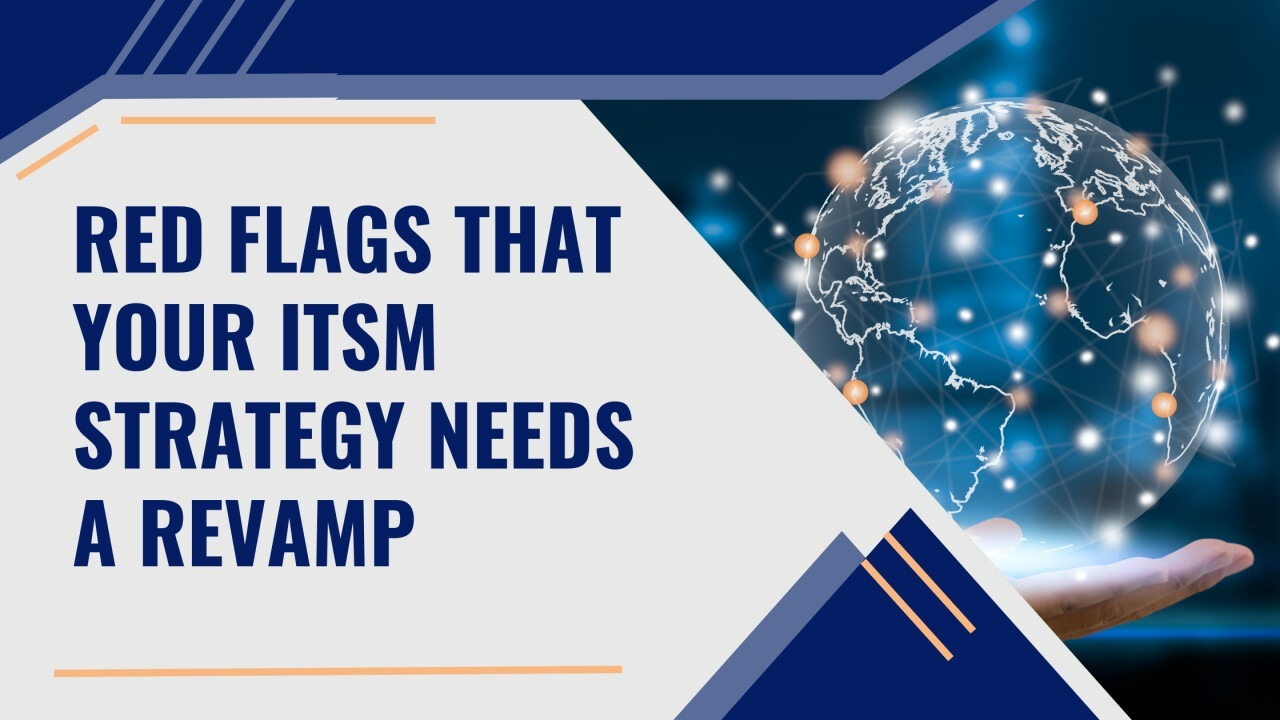When is it time to break up with your current IT Service Management (ITSM) solution and seek out greener pastures? It’s a hard choice to make. ITSM is an essential element in modern organizations, but not all ITSM strategies or tools are created equally.
If you’re experiencing any of the 12 symptoms listed below, your ITSM strategy is showing signs of aging, and it’s time to look for new options.
1.Lack of agile mindset
Embracing the agile mindset outlined in the Agile Manifesto is essential for organizations to overcome the limitations of traditional management approaches.
The manifesto emphasizes the value of individuals and interactions, working software, customer collaboration, and responsiveness to change. An agile mindset enables quicker turnarounds, enhanced transparency, improved product quality through continuous feedback, and effective resource management in dynamic environments.
Without this mindset, teams can become stagnant, prioritizing outdated visions over short-term goals and wasting resources. Innovation is stifled due to slow feedback cycles, and rigid documentation practices can lead to costly delays if project requirements change. Failing to adopt an agile mindset in ITSM implementation risks being left behind, as Gartner reports that organizations neglecting agility will have their ITSM practices overlooked as other areas of the organization embrace more agile processes.
2.Silos and disparate tools
Traditional service management tools often contribute to siloed and fragmented operations, hindering IT and operations teams from adopting an agile mindset and collaborating effectively with other departments.
Without embracing agility, siloed resources and disparate tools become barriers to both IT service management strategy and overall business innovation. Industry data highlights the pressing need for digital transformation, agility, and rapid service release to remain competitive in the modern business landscape.
Recognizing the detrimental effects of silos and disparate tools is crucial, as it signifies the urgency to address and improve your IT service management strategy.
3.It’s difficult for diverse teams to deliver services
Traditional service management tools suffer from an inflexible mindset that hinders diverse teams from effectively delivering services. These tools promote an individualistic approach that inhibits collaboration and impedes results.
Departments like human resources, facilities, and finance encounter obstacles in serving internal customers due to the increasing need for collaborative and unstructured work, which traditional service management fails to address.
To overcome these limitations, service management solutions must prioritize openness, collaboration, and transparency. Atlassian’s Jira Service Management is designed with these principles in mind, offering a user-friendly low-code environment that can be easily adopted across the organization. Unlike other cumbersome tools, Jira Service Management supports multiple teams, enabling diverse departments to deliver services efficiently and build better connections with customers.
4.Command and control approach
Agility is paramount in modern business environments where key stakeholders need autonomy to ensure consistent alignment in operations. To guarantee agility, your teams need flexibility and simplicity.
Unfortunately, traditional service request tools may use an outdated command and control approach that’s rigid and overly centralized. This inflexible one-size-fits-all approach doesn’t follow the agile methodologies that define modern ITSM implementation strategies. By design, traditional service management approaches and tools limit your ITSM strategy.
5.Unnecessary or redundant tools
Having more tools does not always equate to better outcomes in IT service management (ITSM). In fact, unused or redundant tools can drive up costs and hinder efficiency by introducing unnecessary steps and complexities into workflows.
Legacy service management software often exaggerates the number of tools offered, promoting over 100 options when only a fraction are truly necessary. These tools are falsely marketed as a remedy for organizational siloing issues, deceiving buyers into unnecessary purchases.
According to Gartner, it is common for businesses to overinvest in service desk software tools, resulting in excessive spending and increased overhead costs. Gartner predicts that in 2023 alone, organizations will waste $750 million on unused ITSM tools. Avoid becoming part of this statistic by carefully evaluating your tooling needs and resisting the temptation to acquire more than what is essential for your specific requirements.
Also Read: Financial Benefits of Moving to the Cloud with the Right Partner
6.Unable to adapt to business needs
Your IT service management (ITSM) solution should possess the ability to adapt and scale alongside your evolving business needs. It is crucial to recognize that ITSM is not a static methodology and requires tools that can keep pace with your organization’s growth. Flexibility in both your ITSM strategy and the underlying tools is indispensable, as it allows for seamless adjustments and ensures alignment with your evolving operational requirements.
When encountering significant misalignment in your ITSM strategy, it is essential to carefully evaluate the potential gaps that may exist. Providers or infrastructure that lack flexibility can impede the implementation of your service desk software, especially during unplanned changes or rapid scaling of operations, leading to various downstream issues.
An inflexible ITSM solution can also result in downtime and outages caused by poorly planned or challenging IT changes. According to Gartner, the average cost of IT downtime amounts to $5,600 per minute of service unavailability. These figures underscore the significant impact that a flexible and scalable ITSM solution can have on your reliability and overall profitability.
7. Ballooning costs
If your IT service management (ITSM) software costs are increasing without a corresponding improvement in returns, it indicates that you are overpaying for the solution. ITSM expenses extend beyond the initial implementation and include ongoing costs like subscription and licensing fees, maintenance expenses, annual fees, and personnel costs. If these costs continue to rise without operational improvements, it suggests that your service desk solution is not delivering value for the investment.
There are several reasons for escalating costs, such as underutilization of the solution’s features. It is crucial to evaluate whether you genuinely need all the features and discuss with the provider to remove unnecessary ones to reduce pricing. If that is not feasible, it indicates that your current ticketing software is no longer suitable for your organization.
Additionally, hidden or unexpected fees in traditional service management tools, along with costs for add-on modules, upgrades, and consultants, can contribute to rising expenses. Carefully scrutinizing the fine print and addressing any missing components is essential.
If you are using your service desk software effectively, there are no hidden fees, yet costs continue to increase, it signifies a mismatch between the budget and value obtained. In such cases, it is advisable to consider moving on from your current solution.
8.Lack of effective automation
Automation plays a pivotal role in service request management by minimizing or replacing manual intervention, particularly in repetitive daily tasks that are both time-consuming and necessary. A successful IT service management (ITSM) strategy embraces extensive automation while continuously exploring new areas where the organization can derive value from it.
By implementing effective automation, the workload on employees is reduced, allowing them to focus on more significant responsibilities. However, it is essential to prioritize “effective” automation, avoiding automation for its own sake. If your automation strategies are ineffective, and your service desk tools fail to provide the necessary automation capabilities without the need for additional tool purchases, it may be time to consider alternative solutions.
Consider Atlassian Intelligence that uses AI internal models and Atlassian’s collaboration with OpenAI to provide your team with a new virtual teammate that deeply understands how they collaborate to accelerate work.
In Jira Service Management, the virtual agent integrates seamlessly with popular collaboration tools like Slack and Microsoft Teams, enabling employees to receive support without leaving their preferred platforms. The virtual agent handles repetitive requests on behalf of support teams, freeing them to concentrate on higher-priority tasks. Setting up the virtual agent is quick and straightforward, requiring no coding, data science expertise, or expensive consultants.
9.Lack of product-centric service delivery
To thrive in today’s customer-centric landscape, traditional teams must shift their mindset and consider the entire service delivery lifecycle, moving beyond a sole focus on operations.
Service owners need to adopt a product-centric approach, prioritizing the needs of the customer throughout the concept, launch, and operational phases. The emphasis should be on improving the customer experience rather than adhering to rigid structures.
By embracing product centricity, teams can ensure their product is high-performing, readily available, and enjoyable for users, thereby enhancing the overall user experience. If your IT team has not embraced this approach, it is crucial to evaluate your investment and make necessary adjustments.
10.New tools, no improvements
In line with unnecessary or redundant tools that tend to balloon costs, if your IT service management suite introduces a new tool, there should be noticeable positive effects downstream. Efficiency, automation, and collaboration should all improve. These tools should benefit your team, your product, and, in turn, your users. If there are no substantial improvements in metrics, the introduction of that tool is, at best, unnecessary. And if there are decreases in KPIs, then at worst, you’re paying for a tool that’s detrimental to your service desk software implementation.
11.Unreliable provider and infrastructure
Early detection of issues related to unreliable service providers is crucial. If you notice signs of unreliability or hidden fees and inflexibility, it is advisable to discontinue the partnership and reflect on the warning signs that were initially overlooked.
It can be difficult to attribute service management problems to the provider, especially if there has been a long-standing relationship. However, changes in management, policies, outdated technology, and limited service offerings can all contribute to IT service management challenges.
Also Read: Atlassian Tools To Streamline Your Software Delivery Process
12.Backlog keeps growing
Addressing an expanding backlog can be a challenging and elusive task. To tackle this issue, it is essential to investigate and identify any underlying factors contributing to the backlog growth or hindering its resolution. By conducting thorough investigative work, you can uncover both fixable and non-fixable issues, as well as policy-related factors that may worsen the problem.
Non-fixable issues are related to limitations within your current service management solution, necessitating a switch to a different provider.
Additionally, policy factors, such as a flawed incident management ticket template that lacks crucial information, can contribute to backlog growth. For instance, asking “What caused the incident?” without providing guidance on the “how” often leads to unhelpful answers.
Adhering to well-documented and standardized ITSM frameworks is crucial to avoid such pitfalls and promote efficient backlog management. To facilitate effective and efficient backlog remediation, it is crucial to have a help desk solution that supports streamlined processes. Automation plays a vital role in this regard, as it enables organizations to clean their backlog more rapidly, leading to faster issue resolution and an increased capacity to address incidents.
Incorporating Atlassian Knowledge Base articles into your ticketing system, utilizing integrations with tools like Confluence and Jira Software, can provide a comprehensive response.
This integration allows for direct linking of Knowledge Base articles from incident tickets, providing valuable documentation that offers insights into issue origins and recommended steps for resolution, ultimately reducing backlog size and promoting timely incident resolution.
Conclusion
When multiple unaddressed or unresolved IT issues persist, it becomes evident that a reassessment of IT service management (ITSM) strategy is necessary. These problems often stem from outdated ITSM tools that reinforce siloed operations and inefficient collaboration. Such tools are inflexible, lack a product-centric approach, and may include redundant or unnecessary features that add complexity instead of providing value through automation. Merely addressing the symptoms is insufficient; it is crucial to address the underlying mindsets that led to these issues and prioritize long-term growth, flexibility, and provider transparency when selecting ITSM tools.
Atlassian Cloud offers a comprehensive suite of ITSM tools, including Jira Service Management, Confluence, and Jira Software, designed to address these challenges. These flexible, agile, and cost-effective solutions can adapt and scale with organizations, reducing the occurrence of warning signs.
The essence of IT Service Management (ITSM) lies in delivering IT as a service. The time has come to embrace ITSM approaches that highlight seamless collaboration, user-friendly interfaces, and the rapid delivery of value. As a distinguished ITSM Solution Provider, MicroGenesis leverages its expertise to offer you invaluable recommendations and resources. Our mission is to support your endeavor in transforming your organization into a high-velocity, service-focused powerhouse.
If your organization identifies warning signs, it is time to consider changing your ITSM strategy and contacting us to break free from your current ITSM solution!




